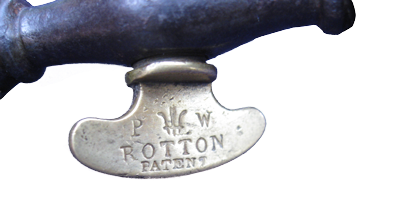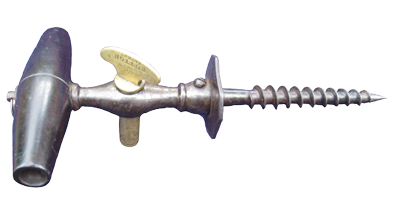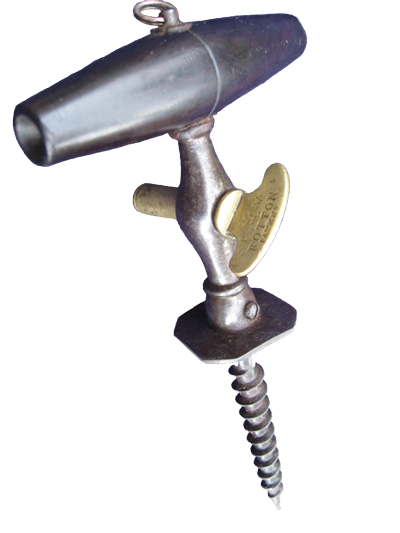Rotton Corkscrew
This article first appeared in The BST
I would have liked to have written this article for the BST having discovered a “new” 18TH Century corkscrew maker. Unfortunately, after having carried out a considerable amount of research, my findings are not conclusive. However, I feel these findings to be of enough interest to put pen to paper, though my research on this topic will be a work in progress.
Back in the middle of the summer this year (2010), I received a telephone call from Chris Barge, a great friend with a healthy interest in corkscrews, who was in France at the time. He told me that he’d heard about a very rare and interesting corkscrew that was about to come up for auction in Salisbury, England . The corkscrew was a champagne corkscrew which was marked “Rotton” and “PW” with ostrich feathers curved outwards as a plume, a symbol which happens also to be the crest of the Prince of Wales. It also sports a square button with the corners cut off.

Initially, interest was raised through Bert Giulian’s book on corkscrews, “Corkscrews of the 18th Century, Artistry in Iron & Steel”. On page 176, Bert writes about a two pillar corkscrew marked “Rotton”. Continuing in paragraph 2, it reads, “The corkscrew was probably designed by the London cutler named Rotton c1770”. The two pillar corkscrew mentioned in the book interestingly has exactly the same markings as the champagne corkscrew in this article. Could this champagne corkscrew be from around c1770??. At the moment there is no conclusive proof.
If I can eventually prove the corkscrew to be around this date it would be of considerable interest, as it would pre-date Henshall’s patent for the Henshall button of 1795. There is much speculation that several corkscrew makers from the 18thc made corkscrew with the Henshall type button before Henshall was granted his patent-- Thomas Read, Miss O’Rourke and possibly Rotton. Fortunately, I purchased the Rotton champagne corkscrew at auction in Salisbury. Owning it obviously stirred my interest in the maker Rotton, so I decided to do some research. So, what have I discovered??
Initially, I was able to trace the name Rotton back as far 1225 to William de Rotthon. This, however, was far too early for our two Rotton corkscrews. But, some further work found that besides the cutler Rotton thought to come from London, a second Rotton appeared by the name of Ambrose Rotton, and he is of more interest to us.Ambrose Rotton was born in 1730 in Birmingham, Warwickshire. Interestingly his occupation is listed as Cutler/Surgical Instrument Maker/Publican. Of course, we know cutlers were found on some occasions to also make corkscrews. But, “publican”, the last word in the description of Rotton’s occupation, evokes even further interest. A publican as a keeper of a “public house” or tavern, certainly makes an even closer connection to corkscrews. We also know Birmingham to be the centre for metal workers/toy makers/corkscrew makers around England in the 18th century.
So far my research has not thrown up any more cutlers or corkscrew makers named Rotton, but I will continue to do research until a definite maker has been found for the two existing Rotton corkscrews, obviously made by the same Rotton. I am now off to the Guild Hall in London, to continue research, then onto the Bodlean Library, Oxford, to search through trade cards and bill heads, hoping to discover more.


I would like to thank Bert Giulian for his research on Rotton along with Fletcher Wallis. I don’t in truth think I have found much that wasn’t already known, but this is hopefully of interest to those in our group.

